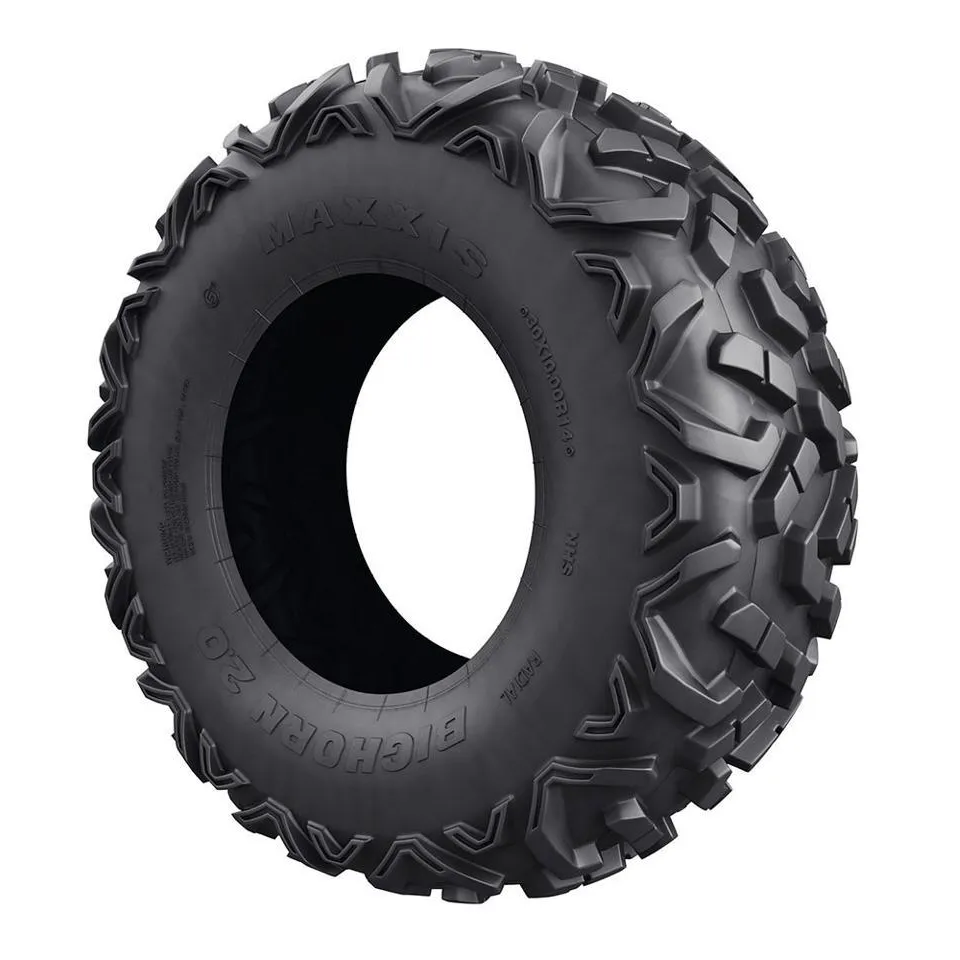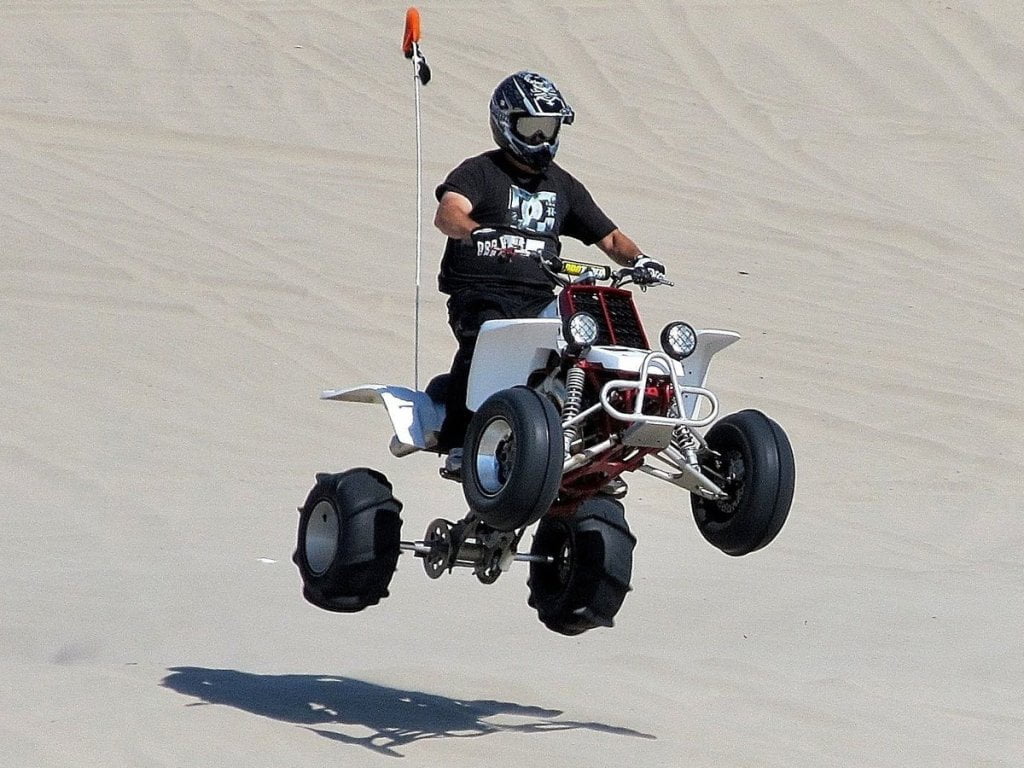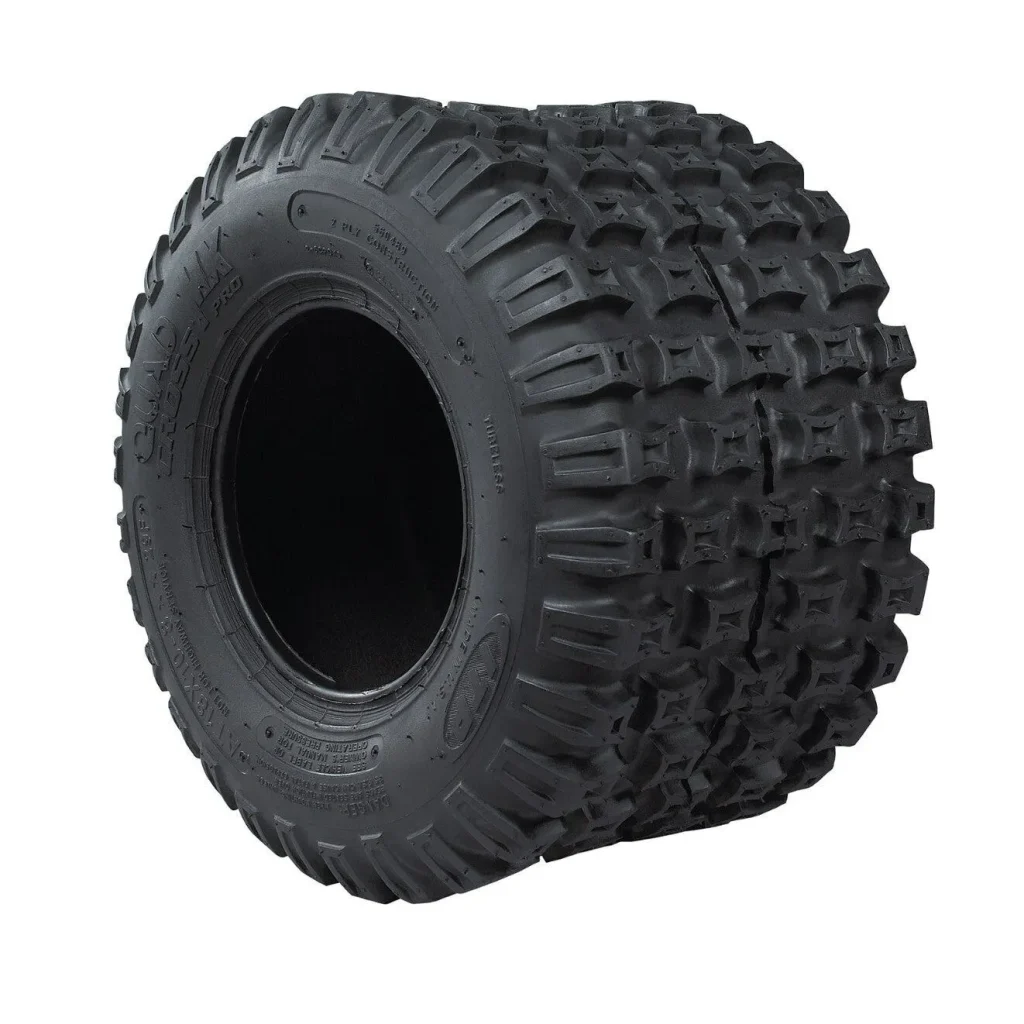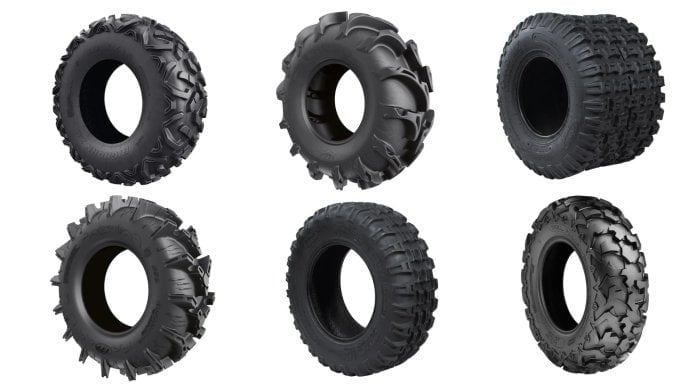The tires are one of the things that make your ATV or UTV stand out from other vehicle types. But what is it that makes this type of tire unique, and what are the different types?
This article covers the basics of ATV tires so that you’re better prepared to make the right choice the next time you’re in the market for a new set.
What Is an ATV/UTV Tire?
ATV is short for All Terrain Vehicle and is a lightweight off/on-road vehicle with four low-pressure tires where the rider sits in a straddled seating position on top.
UTV stands for Utility Terrain vehicle and is an off-road and on-road vehicle with four low-pressure wheels and two or more seats placed side-by-side inside a protective roll cage.
ATV or UTV tires are low-pressure tires with an aggressive tread pattern for optimal off-road performance. The tires come in various tread designs and construction types designed to accommodate a variety of terrains and different off and on-road ATV/UTV riding applications.
Some ATV/UTV tires are designed for general-purpose off-road riding, while others offer a more specialized design geared towards one specific form of riding.
ATV and UTV tire types are typically differentiated by tread design and tire construction. The following sections discuss the differences between the most common designs and construction styles.
Tire Styles and Tread Pattern Designs
The most noticeable difference between various ATV and UTV tires is their tread design.
Varying riding applications and surface conditions constitute different unique tire performance requirements.
Based on tread patterns, ATV and UTV tires are typically divided into tire categories such as All-Terrain, Mud, Sand, Rock, or Racing.
All tire styles except all-terrain tires have a tread-specific design for optimal performance in one specific riding application or terrain. A tire with a tread-specific design will usually not perform well when used in a setting other than it was designed for.
Let us look at what differentiates the different styles and when you should choose one over the other.
All-Terrain Tires

The all-terrain tire is the most commonly used type of tire for ATVs and UTVs. This style is favored due to its versatility and strong performance across everyday riding conditions and terrain.
An all-terrain tire is like a versatile middle ground between all the extremes, which makes it suitable for most typical off-road conditions, including trail riding, gravel, rocks, grass, and light mud.
The lugs are spaced closer than a mud tire, increasing the contact area and traction on firmer surfaces. All-terrain tires usually have a moderate tread depth.
All-terrain tires provide a smooth ride on most surfaces, particularly at higher speeds.
The only times an all-terrain tire falls short are in very soft conditions like heavy mud and desert sands or high-speed on-road use and racing.
Mud Tires

Mud tires stand out with their aggressive, deep, and spread-out lug design. The rugged lugging is to provide traction in extremely wet and muddy conditions.
The lugs on mud tires can be about one inch up to several inches tall and act like paddles.
But the lugs are no good if they are packed with mud. That is why mud tires are designed to be “self-cleaning.”
You’ll notice that the lugs typically sit at an angle, and that is not by accident. When you spin the tire, mud is forced outwards on either side, clearing the mud from the treads. The large spacing between each lug further enhances the self-cleaning effect.
Most mud tires are typically rated 6-ply or more to withstand better the rough use they are exposed to. But because mud tires can be pretty heavy, some brands offer models with a lower ply rating to reduce tire weight.
Using a mud tire on hard surfaces like rock or asphalt is not recommended, as this will cause them to wear down fast.
Sand Tires

Sand tires are specifically designed to provide traction in the loose desert sand. They are easily recognizable by their characteristic paddle-style ridges on wide rear tires and narrow front tires with minimal treads.
Most ATVs used for dune racing or bashing are only rear-wheel drive, so paddles are only on the rear tires.
The purpose of the front tires is to keep the front of the vehicle afloat and for steering. You’ll notice that most front sand tires have a ridge at the center around the tire’s circumstance, which aids with directional stability in the loose sand.
Another difference you notice is that the rear tires are flat across the tire for optimal traction, while the front tire is rounded to sink slightly into the sand for better steering.
Sand tires are incredibly lightweight and usually have a 2-ply rating.
Racing Tires

These tires are specialized lightweight tires for quad racing. The rear tires are knobby with a flat tire profile for maximum traction and high-speed performance on packed trails and race tracks.
The front tires are narrower than the rear and have a rounded tire profile for better turning.
Racing tires typically range from 2-ply to 6-ply ratings.
Related: Are All ATV Tires Directional? How to Tell?
Tire Construction
While the tread pattern typically grabs your attention, knowing that a tire is more than the treads is essential. The rest of the tire, everything underneath the treads, is known as the tire’s body or the carcass.
This section will examine a few fundamental differences in ATV/UTV tire body construction and design.
Bias Ply vs. Radial Tire

ATV and UTV tires come in two main construction types: Radial and Bias ply.
These terms describe how the tire is built internally. Beneath the tread and within the tire itself, there are layers called plies. These plies are made of reinforcing materials, acting as the tire’s foundation to keep its shape.
The materials used for these plies in ATV/UTV tires are usually nylon, but you can also find plies made of steel, Kevlar, or polyester.
The critical difference between bias ply and radial tires lies in the arrangement of these plies. It’s all about how these layers are positioned and aligned in relation to each other.
Bias Ply Tire
On a bias ply tire, the cords or plies are placed in overlapping layers in a crisscross pattern. The plies are placed at angles between 30 and 60 degrees relative to the tire’s direction of travel. That is why bias ply tires are sometimes referred to as diagonal tires.
The constructional carcass plies extend throughout the entire tire from one bead, up the sidewall, across the treaded area, down the other sidewall, and to the other bead.
Some bias ply tires have reinforcing plies in the treaded area, also laid out in a crisscross pattern. These are known as breaker plies.
Bias Ply Tire Benefits
- Usually cheaper to purchase.
- Stiff sidewalls prevent swaying on sidehills.
- More rugged and puncture-resistant sidewalls.
- Uniform construction gives an even flex.
Bias Ply Tire Drawbacks
- A smaller footprint gives poorer flotation in mud.
- A less comfortable ride.
Radial Tires
Radial tires also have a carcass layer of plies that serves as the tire’s structural foundation with a protective layer on top in the treaded area. The main difference is how the structural layers are oriented to each other.
All the carcass plies in a radial tire go from bead to bead at a 90-degree angle relative to the tire’s direction of travel. Unlike the crisscross pattern of a bias ply tire, the layers are stacked parallel and on each other.
Above the 90-degree carcass plies, there are additional layers of belt cords. These cords wrap around the tire’s circumference but are only present over the area with treads.
Radial tires have a lot of benefits over bias ply tires, which is why they are so popular and have quickly become the standard in the ATV/UTV industry.
Radial Tire Benefits
- Smoother and more comfortable ride.
- Better traction and flotation in mud.
- More even and longer-lasting tread wear thanks to better heat dissipation.
- Better performance at higher speeds with more secure handling.
- Better puncture resistance in the treaded area.
- Higher load capacity.
Radial Tire Drawbacks
- More expensive.
- The sidewall is more prone to puncture or tears.
Related: How Much Do ATV Tires Cost – Comparing Different Types
Tire Ply Rating
One of the metrics you need to consider when buying a new set of tires is the ply rating.
Back in the day, the ply rating number represented the number of plies inside the tire walls, but that is no longer the case.
The ply rating in an ATV/UTV tire measures the load capacity and strength on a scale from 2 to 12. 2-ply tires are the lightest but the least rugged, while a 12-ply tire has the toughest sidewalls and the highest payload capacity but is also the heaviest.
Note that some tires use stars rather than numbers as a ply rating. One star represents a 2-ply, so a one-star equals a 2-ply tire, and a three-star equals a 6-ply rating.
Sidewall
The tire sidewall design significantly affects how a tire performs and handles.
As mentioned above, a bias ply tire has stiffer sidewalls, which reduces the sidewall flex and ride comfort. However, they are less likely to slice open from hitting a sharp rock.
Taller sidewall tires perform better and are more comfortable at lower speeds in rugged, while short sidewalls are stiffer, providing better stability at higher speeds and when riding across hills.
Some tires have sidewall tread patterns, which are not just for looks. Sidewall treads can help you get out of a deep rut or up on a rocky ledge and provide additional protection to the tire.
At the bottom of the sidewall, in the bead area, you’ll notice a protruding portion of the tire known as the rim guard. This small but significant detail helps prevent wheel/rim damage and sand and dirt from entering the beaded area of the tire, possibly causing a bead leak.
Related: How to Fix Bead Leak on ATV Tire – Guide With Photos
Tire Profile
Some ATV/UTV tires have a rounded profile, while others have a flat top profile.
- Flat-top tires are typically used to maximize contact surface and traction in racing applications and on rear-wheel sand tires. The downside is a rougher ride.
- A rounded tire profile turns faster and provides better directional stability but not as good traction on harder surfaces.
Related: Are ATV Tires Tubeless? Tubes vs. Tubeless (Pros and Cons)
What Is the Difference Between ATV and UTV Tires
ATV and UTV tires are the same regarding tire structure, tread designs, and size. Still, UTV tires are typically rated at a higher load capacity to accommodate the higher overall vehicle weight and cargo capacity on a UTV.
Should ATV Tires All Be the Same Size?
Most ATVs use the same diameter tire front and rear but usually have a narrow tire at the front and wider tires at the rear.
Tire Pressure (PSI)
Proper tire pressure is crucial to ensure optimal performance, comfort, and safety and to reduce tire wear.
Softer terrains usually require a lower air pressure for better flotation, while when hauling heavy cargo, you need a higher air pressure. Air temperature also plays a role as air expands when it gets hot.
Note that the PSI rating stamped on the tire sidewall is not operating pressure but max PSI the tire can handle when installing the tire to the rim.
Most ATVs have stickers for recommended air pressure during regular operation, or you can refer to the owner’s manual.
Tire Size
ATV/UTV tire sizes are typically advertised in a format like this 27X10R12.
- The First number is the overall tire height in inches when inflated.
- The second number is the overall tire width in inches when inflated.
- The third number is the wheel or rim diameter in inches.
Check this post if you want to learn more about how to read ATV/UTV tire sizes and how to know what size you need.
Related: Will Bigger Tires Make an ATV Faster? (Or Slower?)
Related Questions
What kind of tires do ATVs use?
Most ATVs use radial all-terrain tires designed for general-purpose off-road riding applications across various terrains. Some ATVs have installed terrain-specific tires like mud, sand, or rock.
Related: Do You, Can You, and Should You Balance ATV Tires? Best Way?
